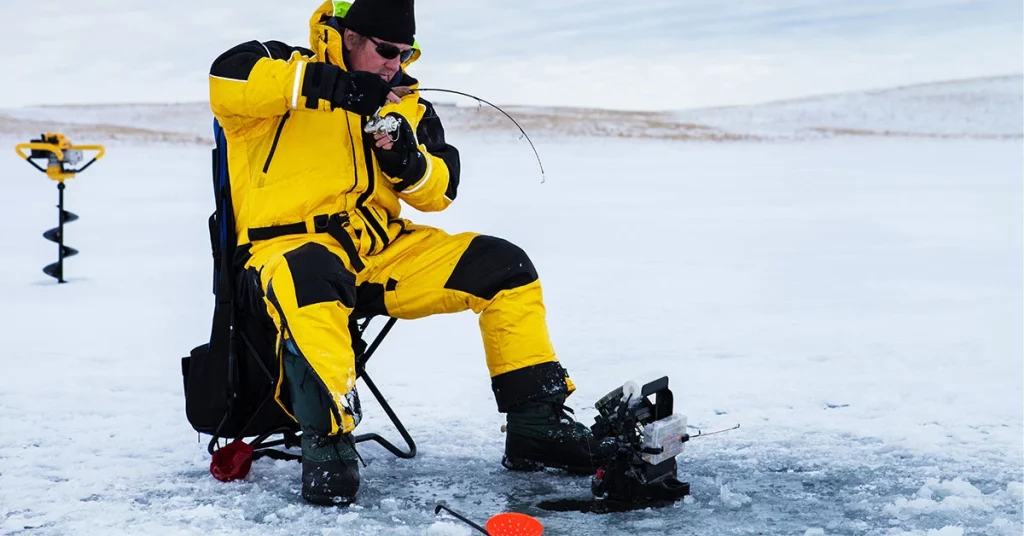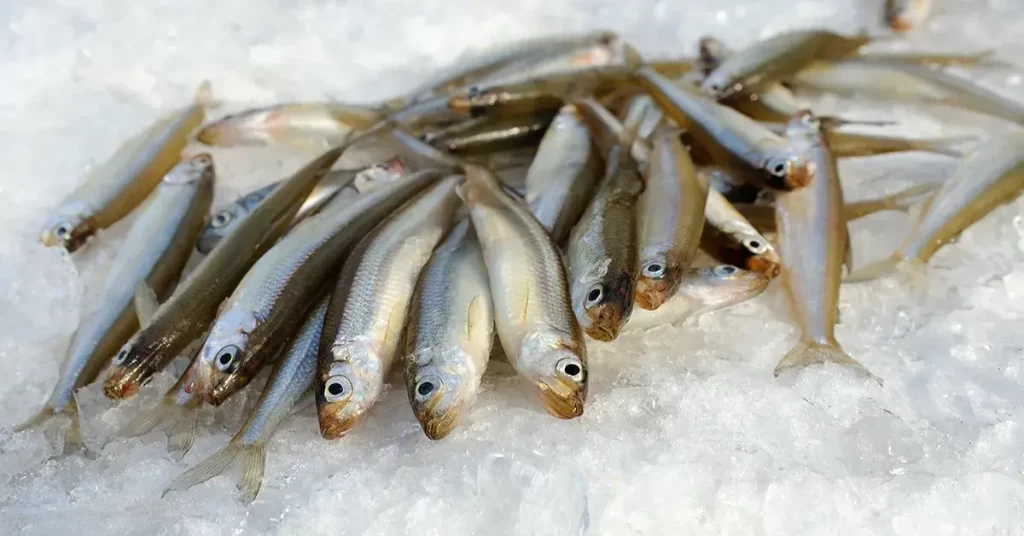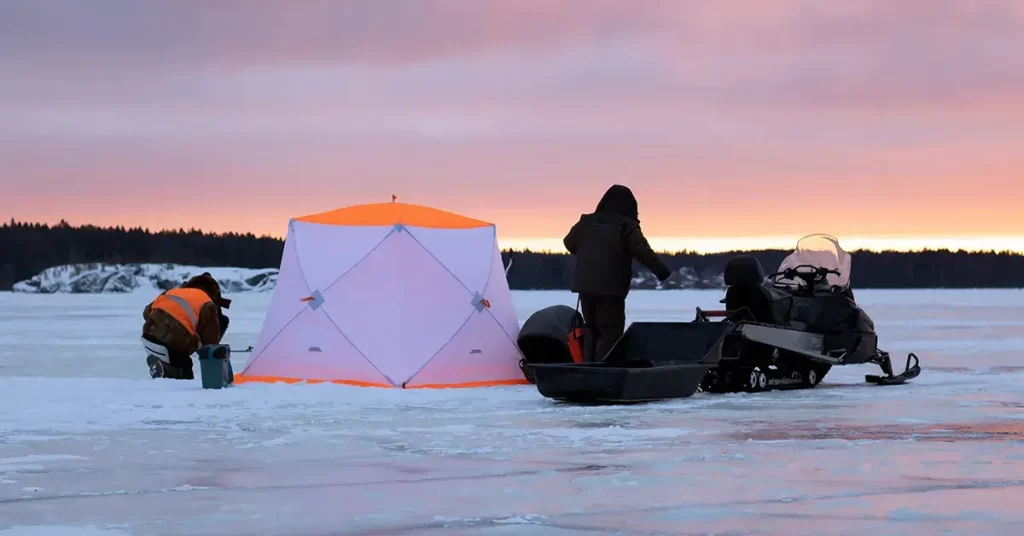I love ice fishing, and I love sharing about it. However, it’s not something to do without knowledge and preparation.
Here in ice fishing 101, I will teach you everything you need to start fishing and begin pulling your catches out of the water. Let’s get right into it, shall we?
Ice Fishing Safety
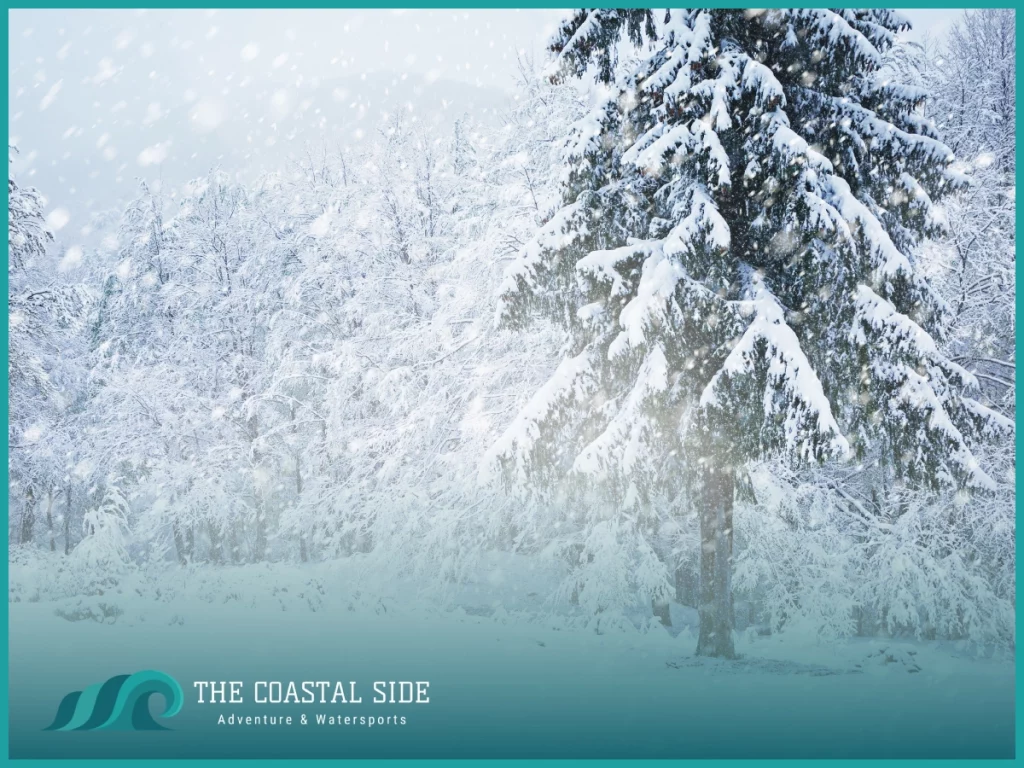
Safety is the first and most important part of ice fishing. Never go fishing when it’s unsafe to do so or when you’re unsure about the conditions out on the ice. Also, make sure you check the weather reports and avoid going out any time a storm is expected.
What Type of Weather Can I Ice Fish in?
Cloudy days are the best for ice fishing, especially when the barometric pressure lowers. Fish can sense changes in atmospheric pressure and tend to become more active when pressure is low– that means better fishing. Bright and sunny days typically have a higher pressure, so you won’t see as many active fish.
How Thick Should the Ice Be for Ice Fishing?
Ice on a frozen lake should be a minimum of four inches thick if you’re going fishing through it. Note that this explicitly means four inches of good ice. If it’s older ice, which isn’t as strong, double the thickness to eight inches of solid ice for safety. Remember, ice may be thicker and more stable further out.
If you’re planning to drive a snowmobile, look for at least five inches of thick, safe ice. If you plan to drive a car onto the ice, try to get eight inches minimum, and preferably more than one foot.
How to Tell If the Ice Is Thick Enough
The best way to tell if ice is thick enough is to first drill a hole down to the water, then use a tape measure to check the thickness. Inspect the ice visually if possible. Remember that ice may be thinner under snow, so look for areas with as little snow as possible when you’re heading out.
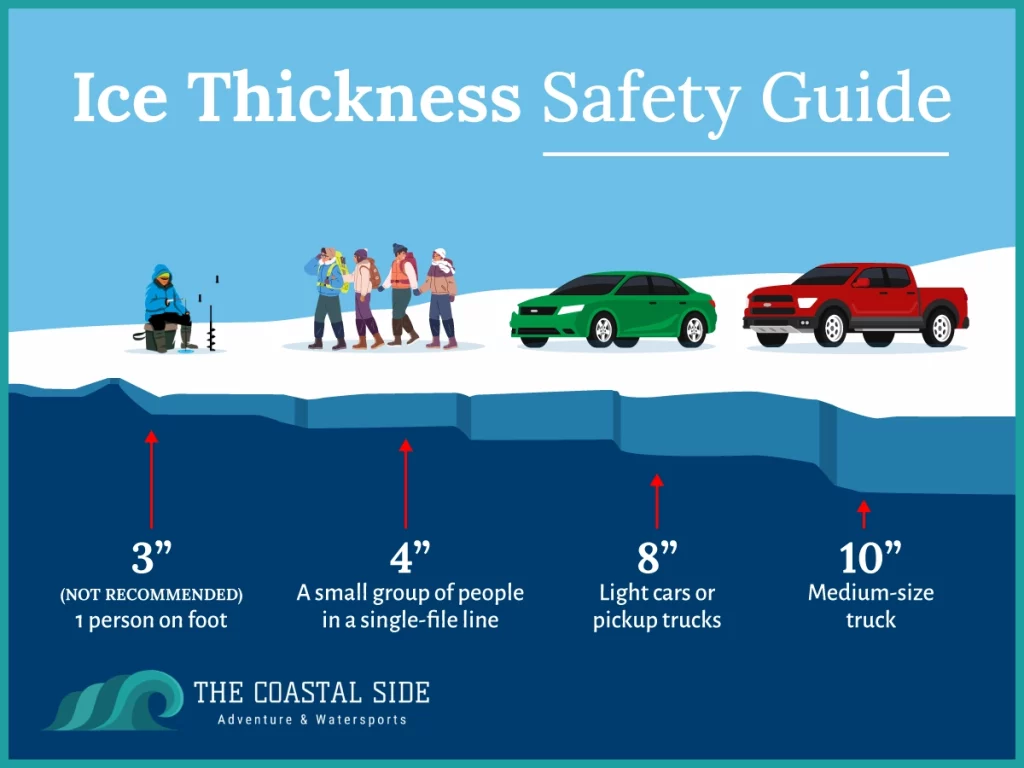
Ice Thickness Chart
| Ice Thickness | Typical Load |
| 3 inches (not recommended) | 1 person on foot |
| 4 inches | A small group of people in a single file line |
| 8 inches | Light cars or pickup trucks |
| 10 inches | Medium-size truck |
Thin Ice Safety Tips
Here are some quick tips for practicing ice safety:
- Distribute your weight as widely as possible to prevent punching through the ice in one spot
- Keep away from flowing water
- Talk to local shops about known areas of unstable ice
- Try to avoid driving over ice
Ice Fishing Safety Equipment
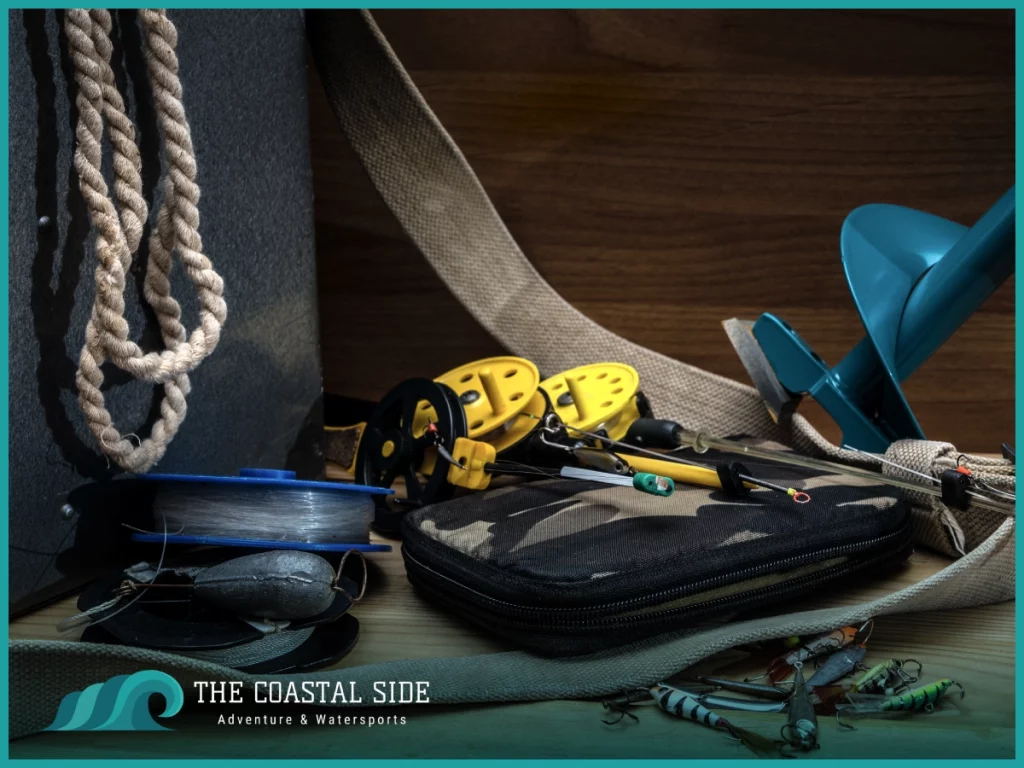
Below are essential equipment pieces you should bring for on any ice fishing trip to stay safe. You can pick up a replacement at any decent fishing store if you forget anything.
1. Life Jacket
Life jackets are vital even if you don’t plan on diving into the freezing water. Put your life preserver on before you start walking over any lake or river areas and don’t take it off until you’re safely on the ground. Do not wait to put your life jacket on until you’re all set up on the ice.
2. Ice Spud
An ice spud is a long steel bar, usually about five feet long. You can use these to break open holes for ice fishing, but more importantly, they give you the reach to test the ice ahead of you. If you can smack the ground a few times with it and the ice holds firm, it should be safe to walk on.
3. Whistle
Whistles are a great way to get attention if you need help. Whether you end up lost in the woods or have a scare and want to maximize the odds of reaching others, whistles are instantly recognizable alerts. Try to keep yours close to your mouth and available to use at a moment’s notice.
4. Ice Pick
Ice picks are small tools that can easily puncture most ice. These have several uses in emergencies, including acting as something you can stab into nearby ice to create a handhold for yourself. Do not underestimate the value of this small, but simple, device.
5. Cleats
I’m always surprised at how many people forget about ice fishing cleats. You can get any design you want, but having shoes that grip better on ice and snow gives you far more traction and leverage in even the worst ice fishing conditions.
6. Emergency Flotation Device
Emergency flotation devices are not the same thing as life jackets. You can attach these things to your vehicle and your tools to provide buoyancy during emergencies. It’s also a good idea to have a separate flotation device for yourself that you can activate on demand. Staying out of the water as much as possible is vital for your trip.
7. Head Flashlight
Head flashlights can help you see what you’re doing, especially if things start to get dark out. You may not need this during a regular trip, but it will let you move through forests and other areas at night. Specifically, get a head flashlight because they leave your hands free.
8. Hand Warmers
Finally, I love hand warmers in cold weather, especially during a deep freeze. I don’t mean comfortable and practical gloves, either. Proper hand warmers offer on-demand warmth that you can use for any part of your body if you get too cold. Be careful about generating too much heat, though, or you may start melting the ice.
What Month Can You Start Ice Fishing?
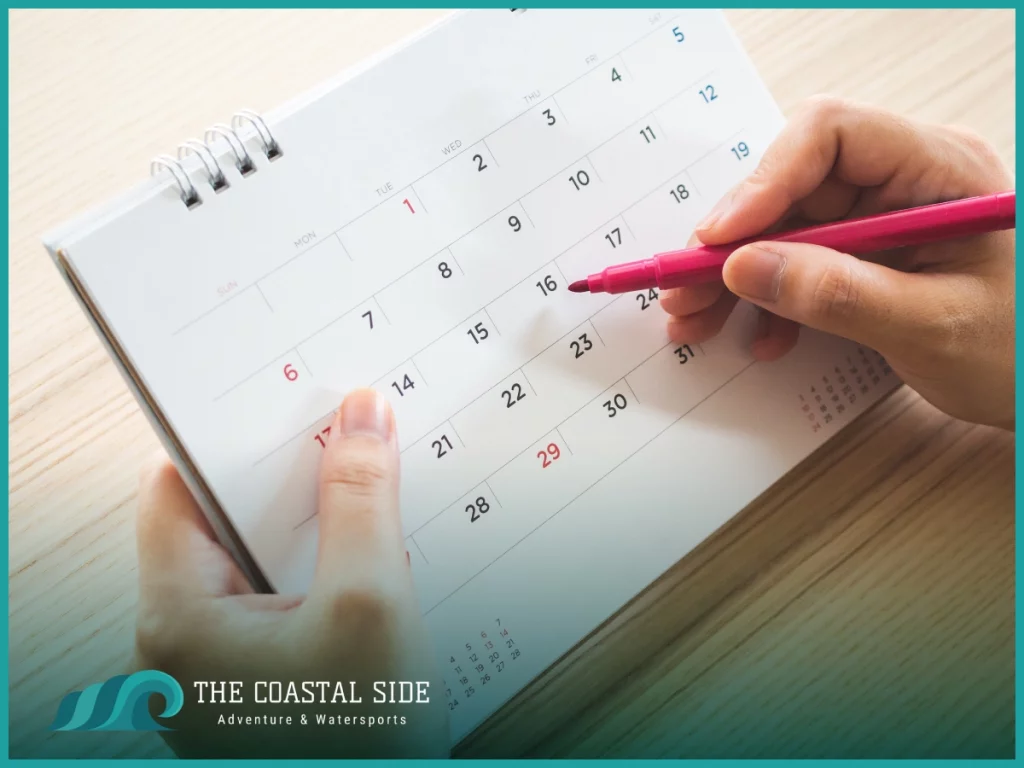
This is one of the most common questions I get when teaching ice fishing 101. As usual, the answer is “it depends.” Specifically, it depends on where you are and where you want to fish. Some areas freeze earlier than others.
What Are the Best Months to Go Ice Fishing?
In most areas, the best months for ice fishing are from December to March. Areas that are cold year-round — like some areas of Canada — may always be good choices for ice fishing. Southern areas usually start later and end sooner.
Best Time of Day to Go Ice Fishing?
While lakes and habitats vary, the best time to catch fish in hard water is the hour right after sunrise and the two hours on either side of sunset. Fish bites tend to increase during these periods because their food moves up and down through the water, thereby increasing the chance to catch more.
Does the Sun Affect Ice Fishing?
Yes, the sun affects ice fishing. Bright days aren’t as good as cloudy days, although fishing at the correct times should help you get a catch regardless.
Can You Go Ice Fishing at Night?
Yes, you can go ice fishing at night, though remember to follow all safety guidelines while doing it. Some species are more active at night, too. Night fishing is excellent if you’re looking for walleye or crappies, but not as good if you want trout or pike.
Locations to Ice Fish
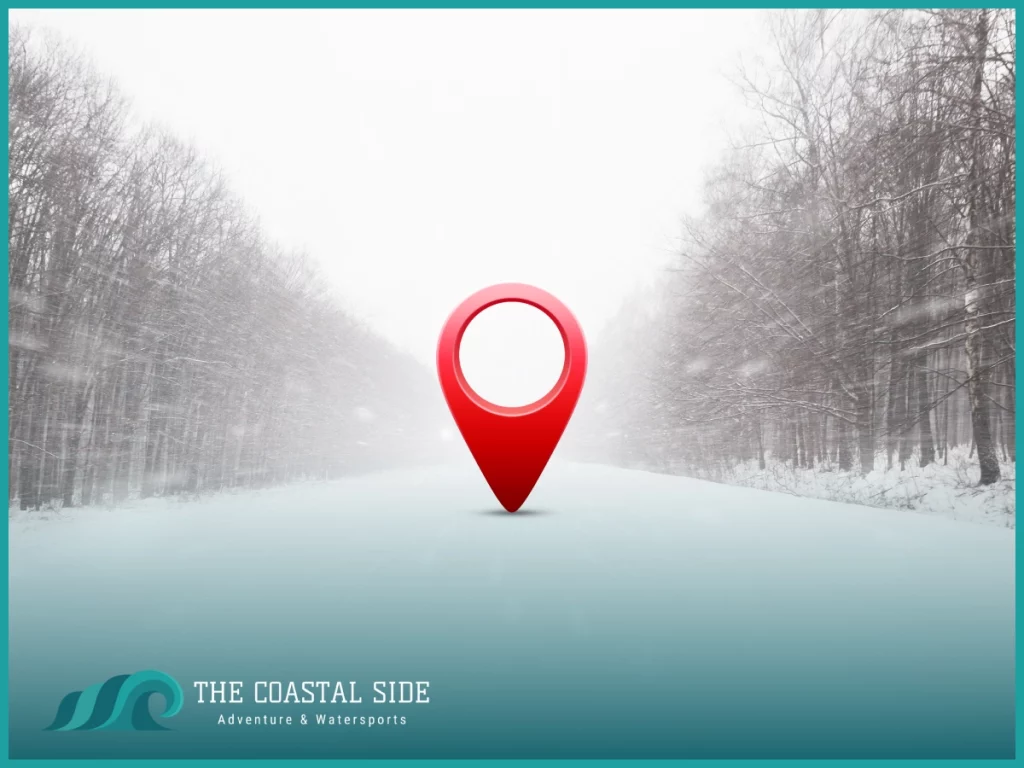
There are many places where you can go ice fishing but some of them are significantly better than others. Here are my recommendations for the best ice fishing areas.
United States
These locations are all within the United States. They’re not the only places you can go ice fishing in the US, but they’re better than most.
Colorado
Colorado is a little more mountainous than some other ice fishing areas. That means you may need to hike or drive to your destination, but it’s also a completely different experience. Expect to see a lot of trout in this state, but places like Chambers Lake also have a high population of salmon.
Michigan
Lake Michigan isn’t just an excellent spot for ice fishing — it’s also accessible from several other states around the area, making it one of the most accessible lakes to reach. The rest of the state is also good, but Lake Michigan has a lot of activities and amenities. This way, you can go on an ice fishing adventure and return quickly to modern comforts and conveniences.
Wisconsin
Wisconsin is like other cold states in supporting ice fishing, but the Lake Winnebago area is excellent for fishing while frozen over. Alongside common catches like trout, the sturgeon that spawn in the area are huge catches and offer a completely different experience.
Alaska
Alaska has over 180 well-stocked lakes, alongside natural spawning areas and cold temperatures throughout the year. Some areas are cold enough to start fishing in October, especially around inland areas where temperatures are always low.
Vermont
Vermont has a relatively narrow ice fishing season, with the best locations only open from mid-January to mid-March. However, the state runs a well-regulated program, and it’s easy enough to catch bass, salmon or trout in their lakes. You can also expect to see other anglers around.
North Dakota
North Dakota experiences the cold early but it’s also a standout location for ice fishing because of Devil’s Lake. This lake has been the single most popular destination in recent years thanks to its extensive stock and thick, safe ice.
Minnesota
Minnesota is also known as “The Land of 10,000 Lakes,” so it’s no surprise that there are plenty of ice fishing opportunities when things start freezing over. The Lake of the Woods is extensive and worth the trip for serious anglers.
Canada
Ice fishing is available across Canada, and this “Ice Fishing 101 Guide” would be absurdly long if I went into too much detail here. The crucial thing to know is that Canada has ice fishing opportunities in large and small areas alike so you can experience almost any type of ice fishing adventure.
What Types of Fish Will You Catch?
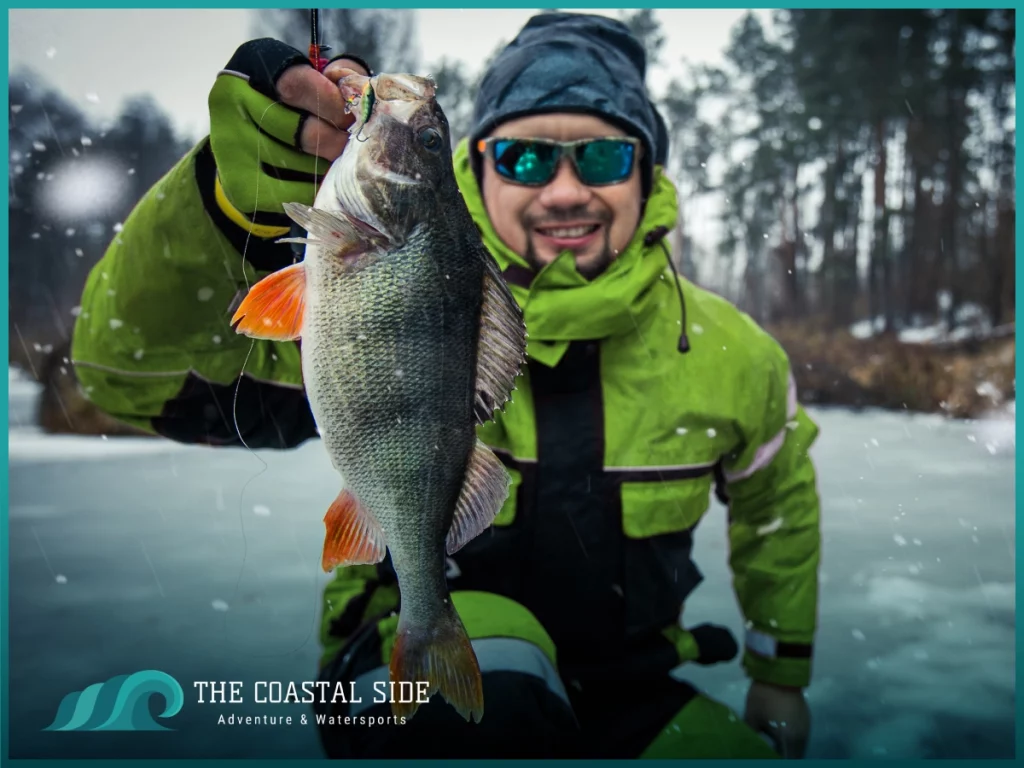
Ultimately, the fish available depend on the lake. Stocked lakes, in particular, may only have one or two types.
Walleye
Walleyes are one of the most common fish you’ll find, especially around dusk and into the night when their better vision comes into play. Many areas artificially stock walleye, but make sure to measure them to see if they’re a legal catch or not.
Crappie
Crappies aren’t as popular as some other types, but they’re easy to catch and fry well in a pan. Look for them around dawn and dusk, when they’re most active.
Perch
Perch are a little harder to catch because they usually put up a fight, but they’re also flavorful and make fantastic meals, especially yellow perch. You can try fishing competitions, too, and limit the fish you keep to those over two pounds.
Panfish
Panfish is a broad term that includes most species that fit inside a pan, including crappies. Most types of sunfish and chub also fit into this category. Panfish availability varies widely, so check lake-specific listings if you want to catch any of these.
Trout
Trout is easily one of the most popular targets for ice fishing— to the point that some people will release anything else. Good trout are both large and flavorful, especially in areas where they can eat crustaceans, impacting their flavor. Trout is widely available across the US.
Northern Pike
Pikes are longer and are famous fighters, often resisting efforts to reel them out of the water. As such, they are an ideal target for anglers who want a challenge. Northern pike tends to have mild-tasting flesh and isn’t as tasty as other species, but large specimens can still make excellent fillets.
Ice Fishing Essentials
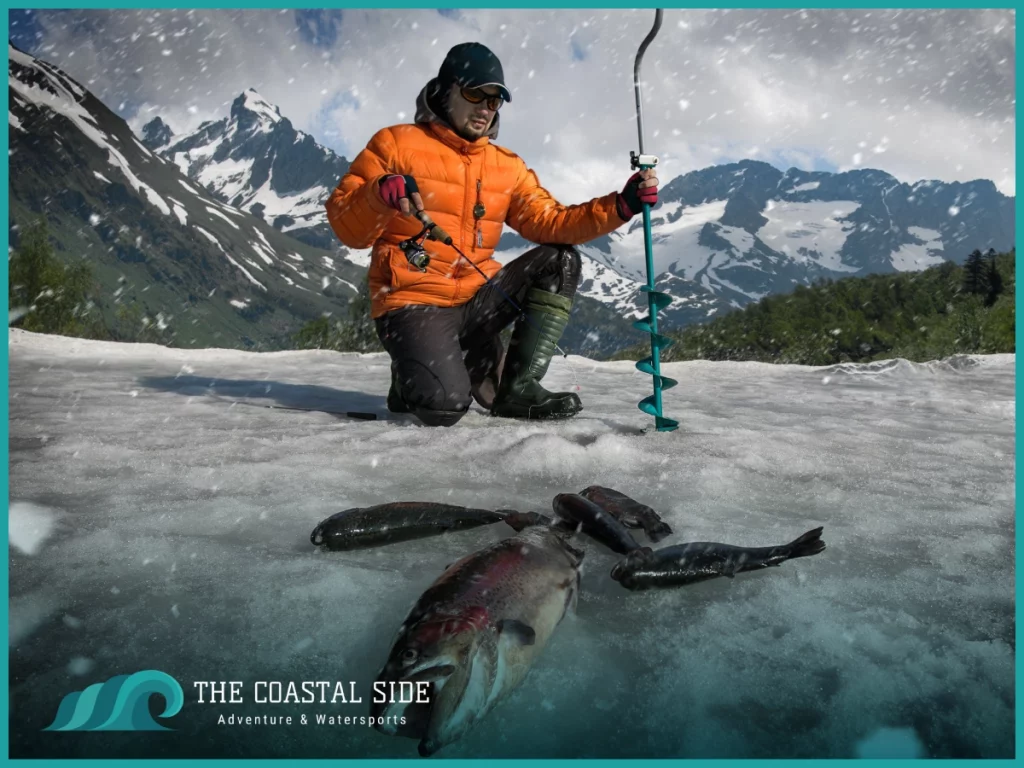
Below are some of the essential ice fishing gear and tools, not including the safety items I discussed earlier. To do it properly, a lot of ice fishing equipment is required, so most people transport it with vehicles or snowmobiles.
1. Warm Clothes
Always dress for the environment! Most ice fishing requires both inner and outer layers while traveling, although you can sometimes take these off if you’re fishing in a cabin or another warmer area.
2. Hat
A good hat is your best friend while fishing. Besides protecting your eyes from the sun and keeping your head warm, a hat can be an excellent place to clip light objects you frequently use.
3. Jacket
A well-made cold weather jacket is your best storage tool when going ice fishing. With enough pockets, you can hold almost everything you might need. Don’t forget that you should practice wearing the jacket and memorize the contents of each pocket before you go out.
4. Gloves
The right type of gloves for your expedition depends on how much agility and control you want. Personally, I think gloves about 5mm thick work best, but 3mm gloves are a good alternative. Consider prioritizing thin gloves if you want to catch fighters — like pike — and comfort if you’re fishing easier targets.
5. Bibs
Ice fishing bibs are suspended pants, usually with extra insulation and numerous additional pockets to help you stay warm. They’re designed to hold fishing gear, so they’re far more helpful than regular pants. They also have high sides to help block the chill.
6. Boots
Thick waterproof boots are a must-have when you’re going ice fishing. Get something comfortable enough to bend your knees in, with ice cleats either built-in or available as an attachment. Rubber boots may not have enough insulation, so don’t rely on those.
7. Socks
Thick socks work with your boots to keep your feet comfortable while you’re fishing. Ensure you measure your footwear while wearing your socks to ensure you get the right fit.
8. Tackle Box
A good tackle box can hold at least several dozen lures and other helpful components. High-quality boxes are always worth the investment, especially if they have durable hinges that won’t break after just a few uses.
9. Ice Rods
Ice rods are different from regular fishing rods, and you shouldn’t use them interchangeably. I’ve tried that, and it simply doesn’t work as well.
Why Are Ice Rods so Short?
An ice fishing rod is short because you usually need to be close to your hole while fishing rather than leisurely setting up lines along the shore. Keeping them short makes it easier to use them as intended.
Types of Ice Fishing Rods
Most companies categorize an ice fishing rod by power, which is the amount of force needed to bend them well enough. Ideally, you’ll match the rod to the fish you’re looking for.
- Ultra-Light: Ultra-light rods are the best choice for panfish. These require the least amount of strength to bend and are ideal for fish that don’t fight very much and are light enough to easily pull out of the water.
- Light: Light rods work well for fish like perch, which fight a little more than panfish but still aren’t overly strong. It takes some practice to feel the difference between a light and an ultra-light rod.
- Medium: Medium rods are a good choice, especially if you’re going for trout or walleye. These are noticeably stiffer than light rods but still have some heft.
- Heavy: Heavy rods are the best choice for the largest and most challenging swimmers, like giant lake trout and pike. Some people make the mistake of trying to use a heavy rod for any large fish, but the truth is that even many large fish are easier to catch with a lighter rod.
10. Ice Fishing Reels
Here are the three types of reels that work best for ice fishing:
Spinning Reel
Spinning reels are popular and offer an excellent balance of durability and efficiency. Beginners and experts alike tend to do well with these, although you won’t see their entire value in ice fishing because you don’t need to cast long distances.
In-Line Ice Reel
In-line reels are designed for ice fishing, so it’s no surprise they work well. Using a large-diameter spindle allows for a faster retrieve, while adjustable disc drags allow better tension control for landing large fish. These are harder to learn than spinning reels but a good choice for competitive anglers.
Straight-Line Reel
Straight-line reels are ideal for ice fishing in shallower water. Their primary focus is minimizing twists and being small enough to easily hold in one hand while you’re fishing.
11. Fishing Line
Fishing line is one of the most critical choices you can make. Many people just choose the strongest line they can get, but picking a line to match your target prey will ultimately work out better.
Choosing the Right Ice Line
The best way to decide on your filament is by the sort of fish you’re looking for. Remember to look for lines described as suitable for this hard water sport.
- Monofilament: Monofilament is the best choice for most situations. It has low visibility, performs well in the cold, and has excellent strength for its diameter. However, monofilament is also somewhat stretchy, and that can make it harder to tell if you’ve got a bite when fishing in deeper water.
- Braid: Braided lines are best when fishing in deeper water. They have practically no stretch, so they’re far more sensitive than monofilament lines and best for biggest fish. However, they’ll also freeze up more and float a little, so they won’t pair well with ultralight jigs.
- Fluorocarbon: Fluorocarbon is a middle-of-the-road line choice. It doesn’t stretch as much as monofilament, and it’s nearly invisible in the water, so it can help hook shy swimmers. Unfortunately, it also has a bit of memory, so coiling too much can make it curve and reduce its effectiveness.
12. Lures and Bait
Review the four main types of lures and bait below to pick what you need to get when going ice fishing.
Jigs
Jigs are ideal for active fishing, where you aim to imitate the erratic movements of real fish to hook a target. This method works exceptionally well when aiming for bigger fish like pike, who are more likely to fall for such bait.
Spoons
Fishing spoons aim to reflect light and fool targets into thinking there’s fleeing or injured bait. Like jigs, these tend to work better for larger fish like trout, salmon, and pike.
Plugs
Fishing plugs are lures that imitate fish food. More specifically, the term “plug” refers to lures that resemble frogs, deeper fish and similar prey. Many people refer to lures that resemble longer and thinner baitfish as “minnows” instead.
Live Bait
Finally, you can bring live bait when ice fishing, although it is more challenging than regular fishing because you need to keep your bait alive in the cold. I only recommend this for experienced anglers– consider bringing a few lures to keep your options open.
13. Shelters
While shelters aren’t strictly necessary for ice fishing, they’re usually safer and more comfortable than fishing directly out on the ice.
Portable
Portable shelters are generally spacious, durable and lightweight. These are ideal if you want to fish in different areas regularly.
Permanent
Permanent shelters are larger, sturdier and safer than portable ones, with the added benefit of being constructed in good places to fish. However, since they’re fixed in place, you’re limited in your choice of venue.
Tents
Tents are functionally cheaper versions of portable shelters, offering only the most minimal protection and insulation while you’re fishing. I don’t recommend these.
14. Chair
Chairs are a necessity for ice fishing in comfort. I suggest looking for one with compartments on it to hook or hang your equipment.
15. Cooler
Coolers are critical for bringing your catch back and keeping them from rotting in the meantime. If you don’t plan to bring anything back, you may still want to take a cooler to keep perishables cold on your way to and from your destination.
16. Heater
Heaters are at their best when you use them inside a shelter. Don’t make things too hot, but consider putting the heater somewhere you can use it to dry your hands.
17. Ice Auger
Augers are your primary tool for drilling holes through thick ice to fish at all. You need one if you’re going ice fishing.
Electric Augers
Electric power augers are generally reliable as long as their batteries last. Consider bringing solar panels if you expect to use your electric auger regularly to cut holes.
Gas Powered Auger
Gas augers tend to be heavier, but they’re mighty and can get through most ice without difficulty.
Hand Augers
Manual augers, or hand augers, are the lightest but are a slower option than a power auger. These are only good if you have the strength to spare or don’t want to carry a heavier tool to make a hole in the ice.
18. Ice Scoop
Ice scoops are for digging ice and slush out of your hole after digging it. Keep one of these handy in case you need to reshape ice elsewhere, too.
19. Sled
Carrying all of this gear on your back is a bad idea. Whether pulled by hand or by machine, sleds are significantly more practical for moving your equipment across the ice.
20. Optional Ice Fishing Gear
These are more optional pieces of gear. They’re not necessary, but they are helpful.
Camera
Cameras are a great way to document your trip. These are especially valuable if you want to keep visual records of any giant fish you catch.
Sonar
Sonar systems can help you locate fish by reflecting sound energy off of them. Fish can move around a lot, but this does tend to show where they’re hanging out.
- Fish Finders: Fishfinders are usually sonar devices that display the exact location of fish. However, you may occasionally see a non-sonar version, more like underwater cameras, or one with added features.
- Fish Flasher: A fish flasher is a more advanced version of the fish finder, providing information as you explore the area. These take a bit of time to learn, but they’re great for serious sportsmen.
Preparing for Your Day on the Ice
All set? Now it’s time to prepare for your hard water adventure.
Have All of Your Equipment
Make sure you have all of your equipment ready to go. Consider organizing it so you can easily verify that you have everything before you leave.
Get Your Licenses or Permits
Many places require a special fishing license or permit to go ice fishing. Get these as early as you can.
Map Out Your Day
Plan ahead! Know where you plan to be and when. That way, you won’t find yourself lingering too long in one place.
Leave Behind Info on Where You’ll Be for Emergencies
Make sure to tell someone where you’re going to be and at what times. If you can get off an emergency signal, this drastically increases the odds of rescuers finding you.
How to Ice Fish
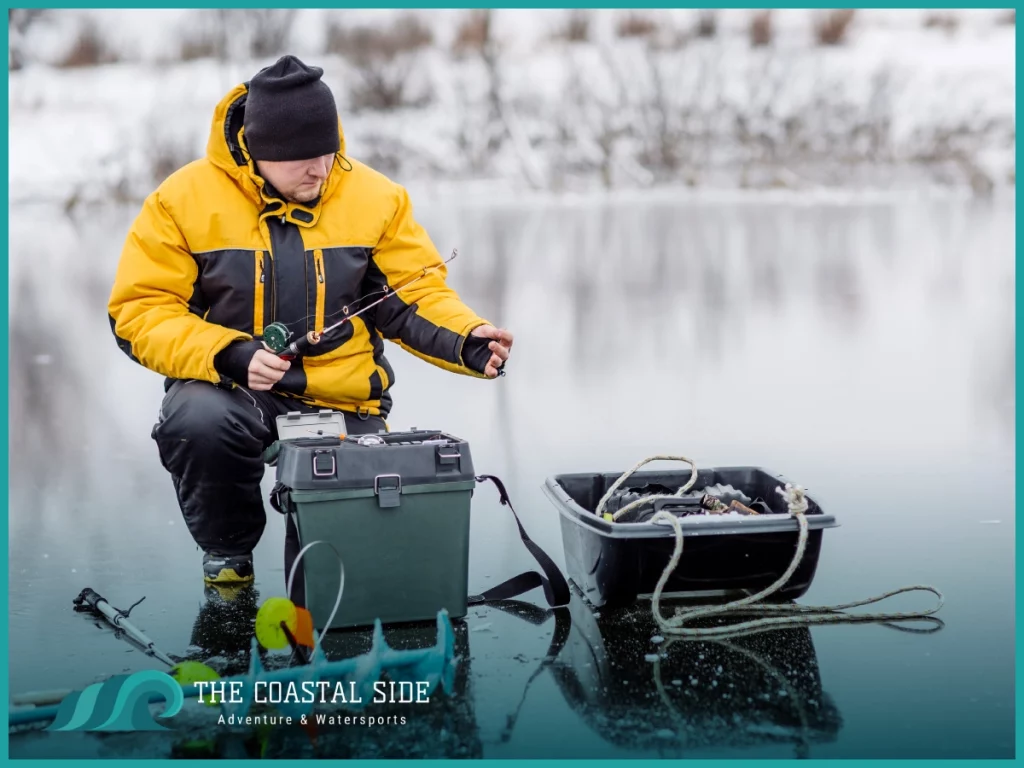
Of course, one of the most critical things when learning ice fishing 101 is how to actually ice fish. Consider the following steps and ice fishing techniques:
Picking Your Location
Pick your location well. You can use sonar equipment to find places where fish are lurking and likely to bite. Remember that different fish tend to like diverse environments, times of day and weather.
How to Drill Your Ice Fishing Hole
Once you’ve picked a spot, plant your feet firmly on the ground. Let the auger do the work of drilling the hole in the ice, but keep it as clear of debris as possible. Consider digging a channel to help remove the slush, and make sure to clean your auger quickly.
Keep Your Hole from Freezing Over
You can keep the hole in the ice from freezing through several methods, including putting a shelter over it or using a simple ice skimmer to occasionally remove any buildup. Periodically moving the line up and down will also make the water ripple and impede ice formation.
How Do You Attract Fish When Ice Fishing?
There are many ways to attract fish while ice fishing, but good lures are sufficient in most areas. You can also add chum or scents to the water. Don’t be afraid to change lures occasionally.
Ways to Ice Fish
Ice fishing looks a bit different than regular fishing. Even if you’re a pro, ensure you brush up on these ice fishing tips and techniques.
1. Jigging
Jigging is the process of letting a jig hook sink to the bottom, then slowly raising it up again. Done correctly, this can fool fish into thinking that there’s food rising away. If it’s too fast, they’ll think it’s energetic and likely to run, so don’t rush this process.
2. Tip Ups
Tip ups are setups that suspend the bait at specific depths and alert a fisher when the bait is taken. Using a tip up for ice fishing is a good technique if you want to have multiple holes.
How to Set Up Your Tip Up
There are several ways to set up a tip up, but I like using a barrel swivel and a leader to help avoid twisting. Follow the linked guide above for specific instructions.
3. Spear Ice Fishing
This is a little more involved and requires actively skewering a fish. Spear ice fishing works best with bigger targets like sturgeon; don’t bother spearing for small panfish.
4. Clubbing
Clubbing is a rare technique these days, and I don’t recommend it. It involves going over thin ice, then smashing it with a wooden club when the fish approach. This can shock and paralyze a fish for long enough to break through the ice and catch them, but it’s also more dangerous than other techniques.
Storing the Fish You Catch
Storing fish is vital if you want to take anything home. If you’re only planning to catch and release, you can safely ignore this section.
Fishing in a Shelter
Storing fish is easiest when you’re in a shelter and can set things up to hold them.
Five Gallon Bucket with Water
A large, five-gallon bucket gives enough space to hold several fish. Keep it relatively full of water to help things stay fresh and add ice as needed to keep it cool.
Fishing in the Open
If you’re fishing in the open, you’ll need something a little more substantial.
Cooler
Start by using a cooler to hold the fish you catch. Make sure you bring a cooler big enough to store things. An average trout can be 30 inches long, so try to get a cooler at least two-and-a-half or three feet long.
Add Ice
Add ice to the cooler to help the fish stay as fresh as possible. This trick limits the potential for decay.
Fish Will More Than Likely Freeze
Chances are your fish will freeze while you’re storing them. If you don’t keep them there for too long, it shouldn’t hurt the flavor much. You’ll need to pay attention if you want to store them long-term, though.
How to Keep Fish Fresh While Ice Fishing
Once you make your first catch, you want to keep it fresh until the end of the trip. Here are some of my tips for keeping fish fresh:
1. Fish Well
Fish wells are containers where you can keep live fish in them for a while to help prevent decay. Beware of attempts to flop out and escape under the ice.
In-Ice Fish Well
You can dig in-ice wells almost anywhere the ice is thick enough. Deeper is usually better, so I recommend places where you have at least a foot of ice to work with.
For these, make multiple rectangular holes in the ice to separate them from your fishing holes. Drill or dig about halfway through the ice so there’s plenty of support underneath. Then poke a hole in the very bottom with your spud to fill it with water. Don’t break the whole base out, though. Store your fish here as needed.
2. Fish Well Bag
Alternatively, you can use a fish well bag after making a hole to help ensure your fish will stay in place. Make sure you stake your bag into the ice and jiggle it occasionally to stop it from freezing.
How Many Fish Can I Keep?
Most places don’t let you keep every fish you catch. Officials do inspect catches– often randomly– so make sure you know local limits.
Check Daily Possession Limits
Daily possession limits are usually posted in local facilities and on websites. Actual numbers vary, but the standard limit is three-to-five for big fish like trout and salmon and up to 20 for more common like perch and white bass.
Culling
Culling is the process of replacing the live catch you currently have, typically in a well as described above, with the one you’ve just fished up. Anglers typically replace poorer catches with better ones as the day goes on, especially in tournaments.
Ending Your Ice Fishing Trip
Fishing trips aren’t over until you’re back home. Ending the journey well is essential, as is making sure you’re not too tired to bring everything back. I’ve done that once, and I don’t recommend repeating my mistake.
Pack Up Equipment
Pack up all of your equipment as you’re getting ready to go, cleaning and drying it as necessary. Make sure to pack things tightly and adequately so they’re easier to store and move.
Put Your Catch on Ice in Cooler
If you’re keeping your haul, put them in a cooler with some ice to keep them fresh until you get home. Make sure to put ice on both sides, so they freeze evenly.
Go Home and Prep Your Fish
Finally, take care of your fish as soon as possible after you get home. That means cutting them, discarding any bits you don’t want and storing them for later. It might be a bit much to do this if you’re fishing past midnight, so take care of it first thing in the morning if you have to wait.
Ice Fishing FAQs
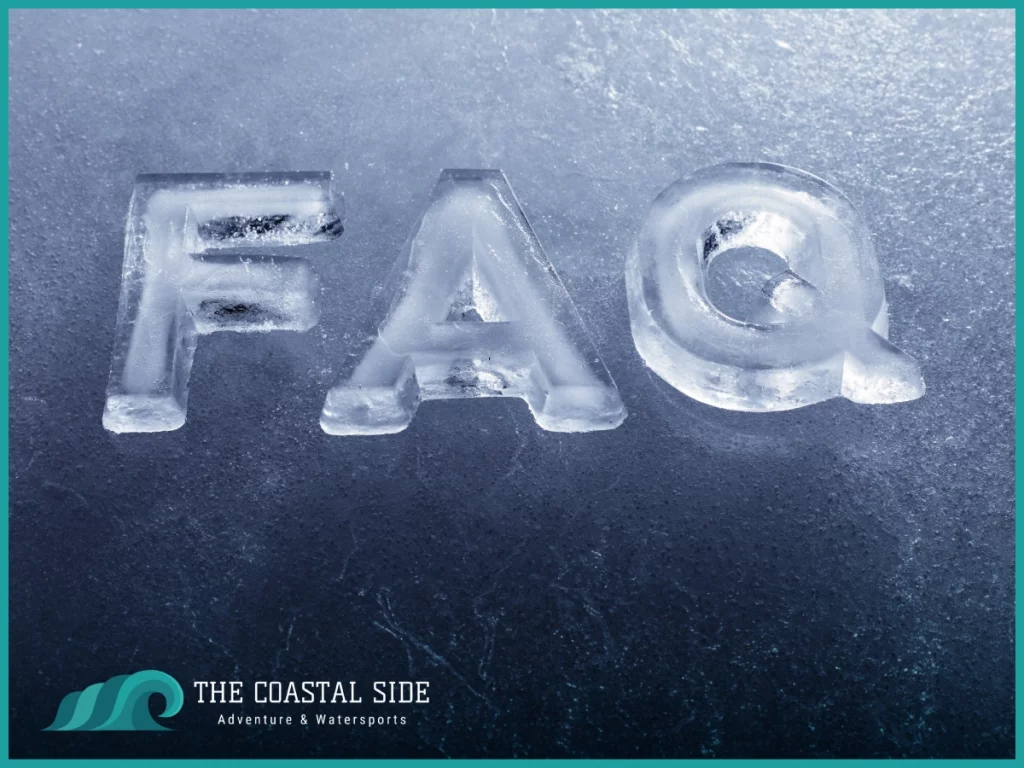
You probably have a few more questions before starting your ice fishing adventure. That’s why I’ve outlined our answers to some of the most common questions people ask about ice fishing.
Who Is Ice Fishing for?
Ice fishing is for everyone! It’s a sport that men, women, kids (with supervision), families and groups can do together. Just make sure to keep people far enough apart instead of clustering together on the ice.
Can I Ice Fish for Just One Day?
Yes! While many people enjoy weekend trips, you can go ice fishing for a single day. These shorter trips are usually more manageable if you can do them close to home and start them in the early morning but you can make them part of a more extended trip as well.
Should I Plan an Ice Fishing Charter If I’m a Beginner?
Ultimately, the answer is up to you. I recommend going on a charter or with an experienced friend for your first trip. That way, you’ll have someone there to give on site instruction.
How Far Apart Should My Shelter Be from My Holes?
That depends on your shelter. Some shelters can go right over your holes, while others are meant to be further away. Consult the directions from the shelter’s manufacturer and follow those exactly.
Should I Fill in My Holes When I’m Done?
Don’t worry about refilling your holes after you’re done fishing. They’ll naturally freeze over soon enough.
Can I Drive a Truck or ATV onto the Ice?
Yes, but only when the ice is thick enough to support it. As a general rule, you want at least ten inches of good ice for heavier vehicles like trucks, and twelve inches wouldn’t be bad. However, it will take much longer to drill through that much ice. It’s better to travel with a lighter vehicle like a snowmobile if possible.
What Is the Best Way to Find out About Ice Fishing Tournaments in My Area?
There are many ways to find out about tournaments, but I prefer checking with local shops. Serious tournaments often advertise there and might not bother putting ads on the internet.
Summary
That’s it for “Ice Fishing 101”! As you learned today, there are many components of proper ice fishing, from having the right gear to selecting the right spot. No guide can ever be a substitute for experience, though, so start gathering your equipment and plan your trip today.

